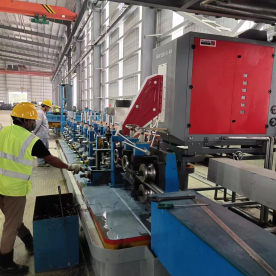[Tube mill production line]Understanding the Tube Mill Production Line: A Comprehensive Guide to Its Components, Functions, and Advantages in Modern Manufacturing
News 2024-11-20
****
Understanding the Tube Mill Production Line: A Comprehensive Guide to Its Components, Functions, and Advantages in Modern Manufacturing
The Basics of Tube Mill Production Lines
A tube mill production line is a complex assembly of machinery designed to manufacture metal tubes through a series of automated processes. The primary material used is steel, although other metals can also be processed. The production line typically starts with cold-rolled or hot-rolled steel strips, which are fed into the mill for further processing. A tube mill system generally consists of several major components, including a decoiler, forming stations, welding stations, sizing sections, and cut-off units.
1. **Decoiler**: This is the initial stage of the production line where the metal coils are unwound and fed into the mill. Decoilers come equipped with automatic tension control, ensuring a constant feed rate.
2. **Forming Stations**: These stations utilize a series of rollers to shape the flat steel strip into a cylindrical form. The design of the rollers and their arrangement is crucial for ensuring the precision of the tube dimensions.
3. **Welding Stations**: Once the strip is formed into a tube shape, it is passed through welding stations where the edges of the strip are fused together. Modern tube mills often use High-Frequency Induction (HFI) welding technology, which ensures a strong bond with minimal distortion.
4. **Sizing Section**: After welding, the tube enters the sizing section, where it is accurately sized to meet specified tolerances. This step is critical as it ensures the final product can be utilized appropriately in its intended application.

Understanding the Tube Mill Production Line: A Comprehensive Guide to Its Components, Functions, and Advantages in Modern Manufacturing

Understanding the Tube Mill Production Line: A Comprehensive Guide to Its Components, Functions, and Advantages in Modern Manufacturing
Advantages of Tube Mill Production Lines
The utilization of a tube mill production line offers several advantages that enhance production efficiency and product output.
1. **Increased Production Speed**: Tube mills operate at high speeds, allowing manufacturers to produce large volumes of tubes in a short period. This rapid output is essential in industries where demand is high, such as construction and automotive sectors.
2. **Cost-Effectiveness**: Automation and continuous operation reduce the labor costs associated with manual welding and cutting processes. The efficient machinery allows for operations with minimal downtime, further lowering the overall cost of production.
3. **Precision and Quality Control**: Modern tube mills are equipped with advanced monitoring systems that help maintain strict quality control throughout the manufacturing process. Automated adjustments can be made in real time to ensure that specifications are met, reducing wastage and increasing customer satisfaction.
4. **Versatility**: Tube mill production lines can be optimized to produce various types of tubes, including round, square, and rectangular shapes, in different sizes and wall thicknesses. This versatility enables manufacturers to cater to diverse market needs.
5. **Sustainability**: Many tube mills are designed with energy efficiency in mind. New technologies minimize waste and allow for the recycling of excess materials, contributing to more sustainable manufacturing practices.
Conclusion
The tube mill production line represents a cornerstone of modern manufacturing, facilitating the efficient production of metal tubes and pipes that are critical to various industries. With components such as decoilers, forming stations, welding stations, sizing sections, and cut-off units working together in harmony, manufacturers can achieve high production speeds while maintaining quality and precision. The numerous advantages, including cost-effectiveness, versatility, and sustainability, make the tube mill production line an invaluable asset for industries seeking to optimize their production processes. Understanding this technology can enhance decision-making for manufacturers looking to invest in or upgrade their production capabilities, ensuring they remain competitive in a constantly evolving marketplace.
